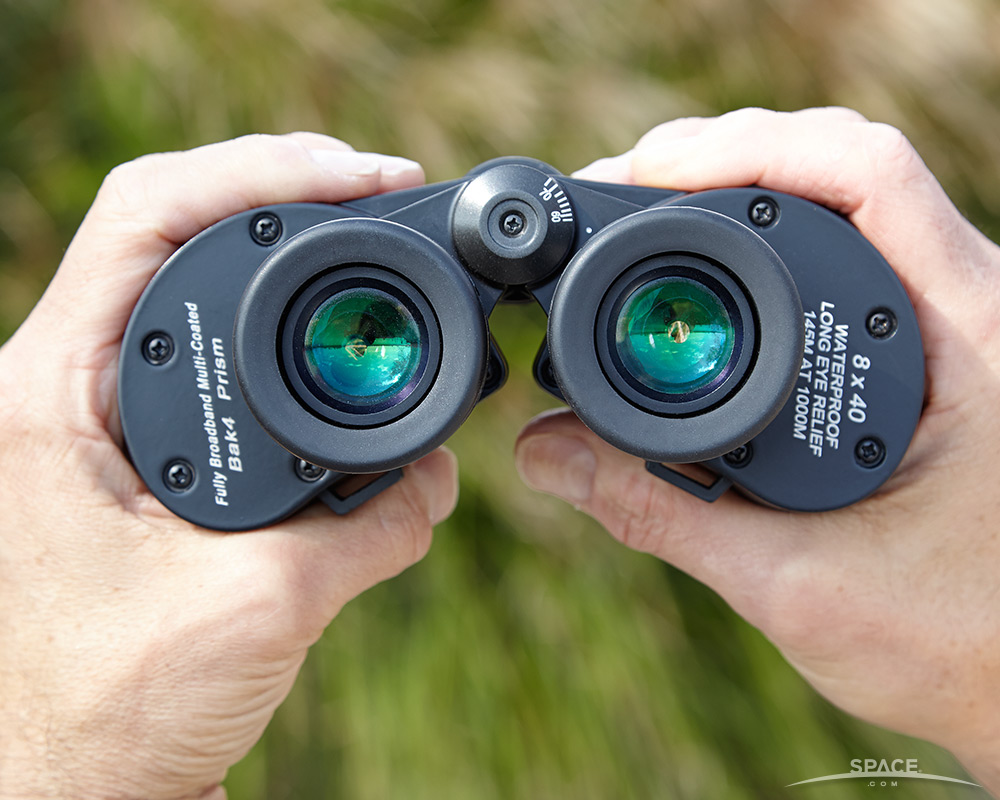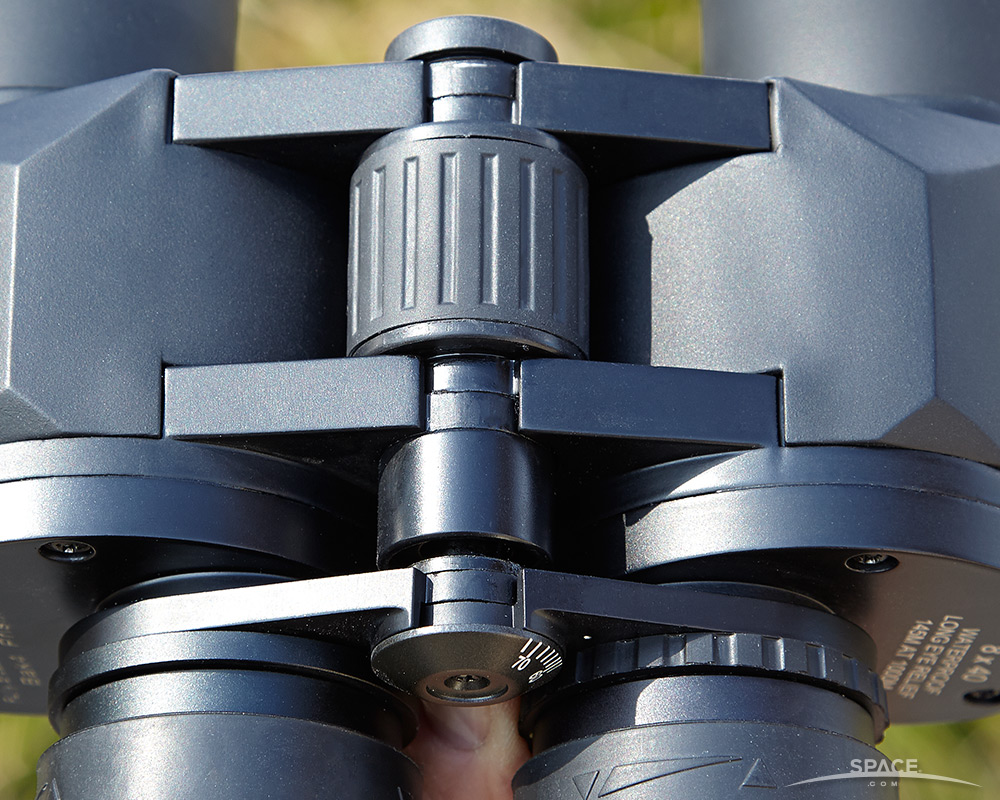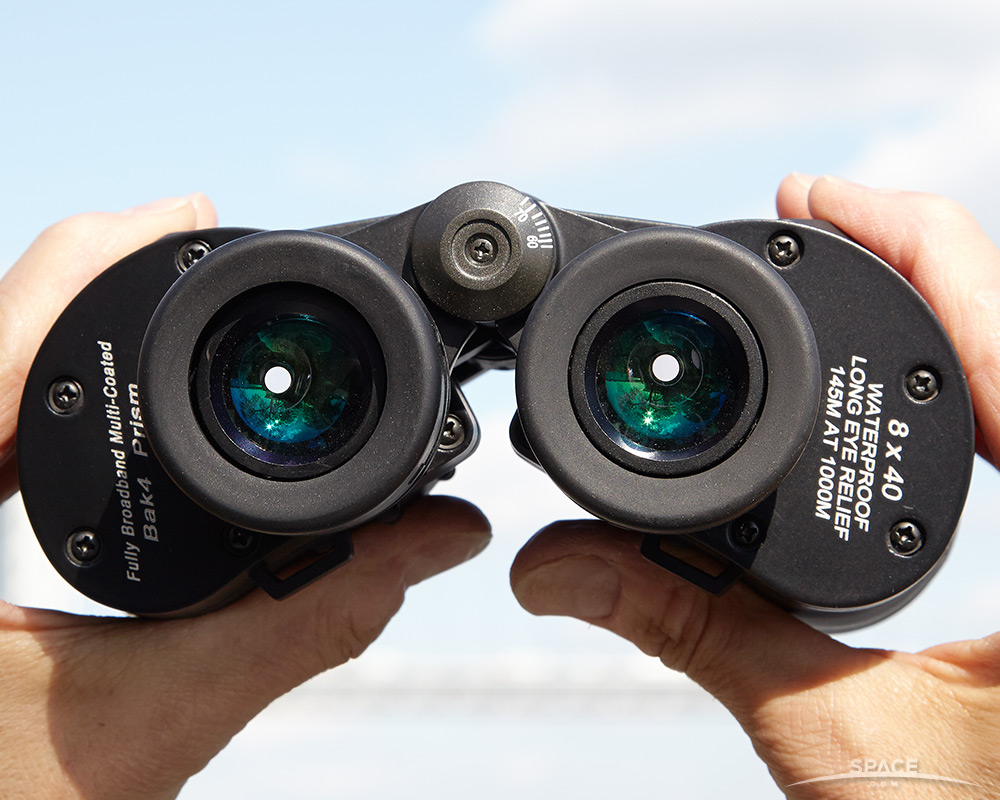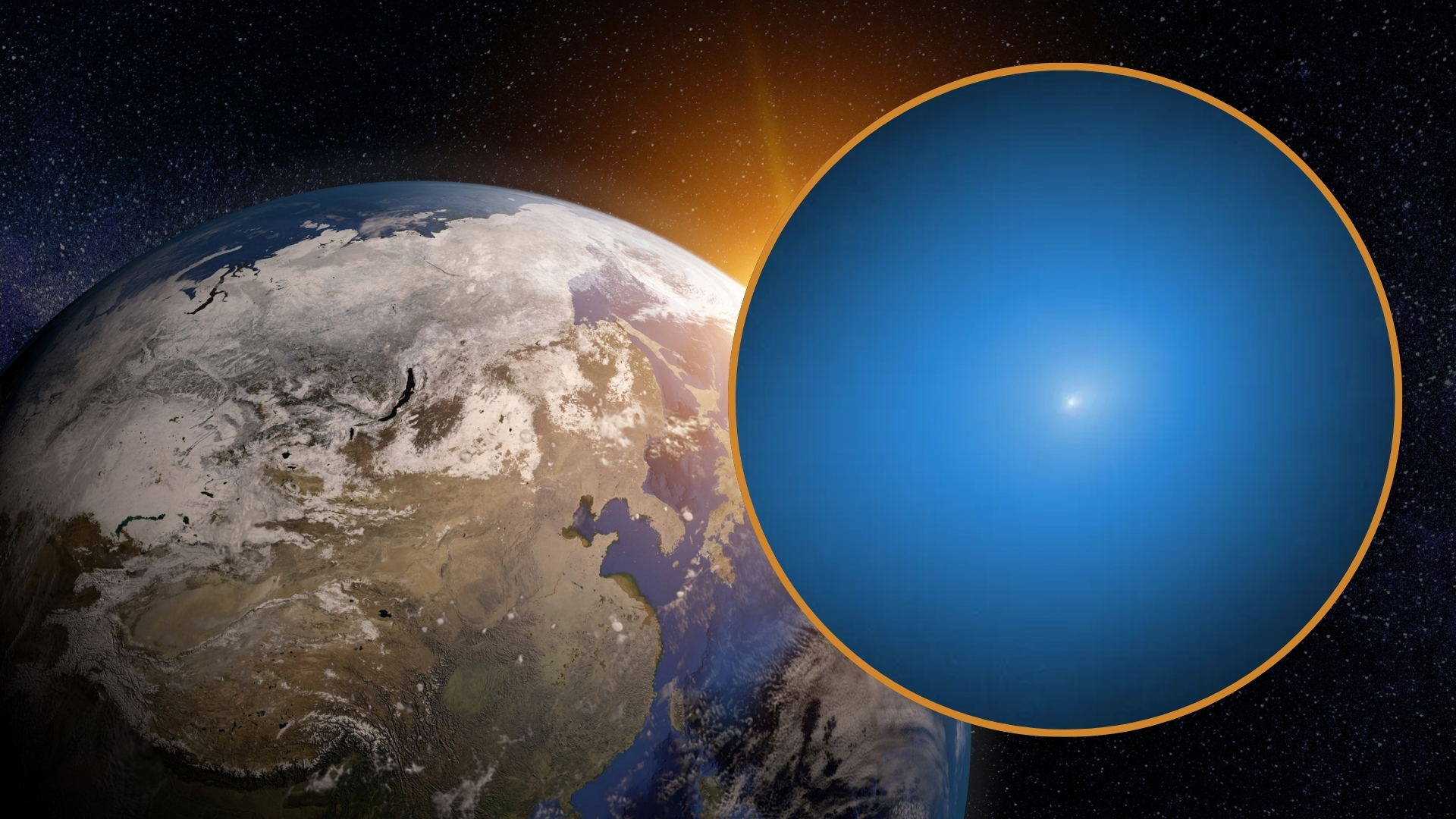Oberwerk Mariner 8x40 Binoculars: Full Review
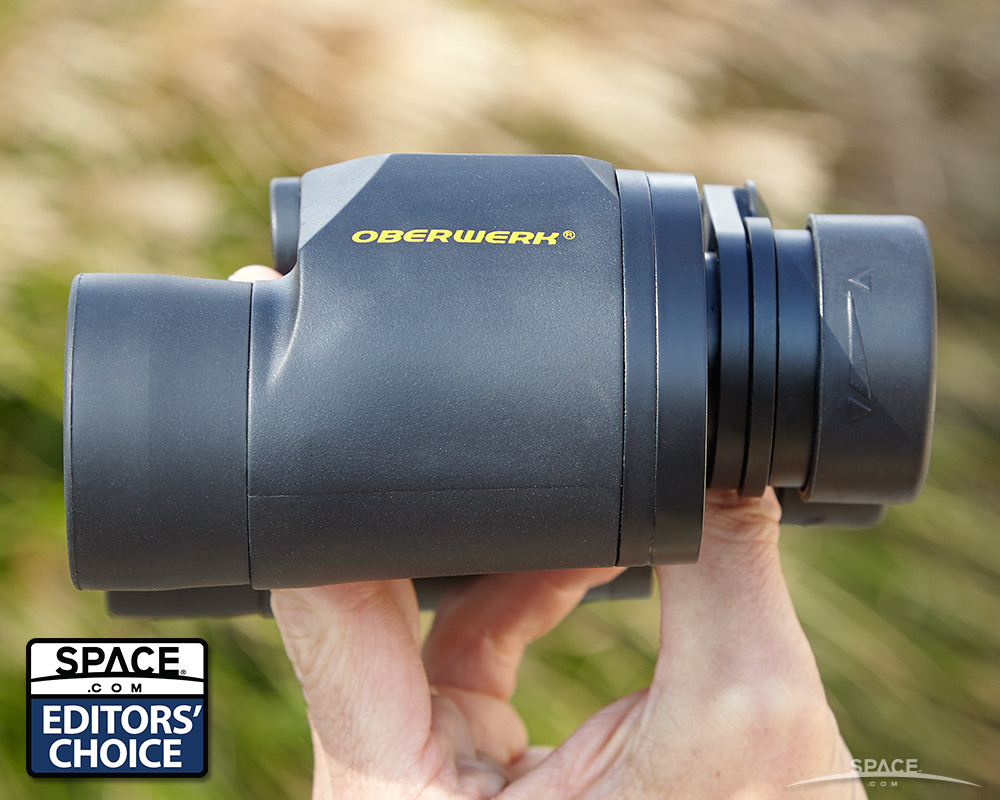
I'm not the world's best planner. A skywatching trip is likely to be a spur of the moment thing. When a clear, dark night rattles my cage, I need to just "grab and go." And I may not put my binoculars back on the shelf until many days, many miles and many other activities later.
The Oberwerk Mariner 8x40s can take the travel. They excel at astronomy. They're totally small enough to wear for a full afternoon of birding or soccer-match watching. And, as the Mariner name implies, they are waterproof and can absorb an occasional bump from sliding across a boat deck or cabin top, without going out of alignment. That's why we've picked the Oberwerk Mariner 8x40 binoculars as our Editors' Choice for Best Small Astronomy Binoculars.
Below: See our Hands On Video Tour of Oberwerk's Mariner 8x40:
At 5.5 inches (14 centimeters) from front to back and 6.5 inches (16.5 cm) wide, these Oberwerks make a brawny, satisfying handful of tech. If you're new to comparing astronomy binoculars, it may strike you as odd that we're calling these "small." Certainly, there are many smaller, lighter binoculars on the market. What we mean is, "small, but still good for astronomy." And at astronomy, these "binos" excel.
Buyer's Guide: How to Choose Binoculars for Stargazing
At 37 ounces (1 kilogram), the 8x40s are a meaty chunk to wield all night long. But they are quite comfortable. They stay out of the way, even if you are also working a telescope. In fact, I found them to be the perfect complement to a telescope. Use your Mariners to scan a wide sky field for an interesting object or region, then warp yourself in closer with your mono 'scope. If you're into astrophotography, you can enjoy the sky with your Oberwerks while your telescope is busy recording photons (during which time, you will NOT want to touch it).
You'll be impressed at the tack-sharp points of stars and the crisp detail when observing lunar terrain with these Mariners. As you reel in the tantalizingly dim, milky light of other galaxies, or of diffuse star clusters within Earth's own galaxy, Oberwerk's impressively high contrast-ratio will sear those stars into your memory. And you may happily lose yourself for many minutes in the celestial depths of the Mariner's unusually wide 8.4-degree field of view. Your mind may switch from just "skywatching" to virtual sky-walking. That's exactly where you want to be.
Breaking space news, the latest updates on rocket launches, skywatching events and more!
Build-quality, optical path and prism design are responsible for the mass factor. These Mariners, like every set of astronomy binoculars we reviewed, use the optically superior "porro-prism" design as opposed to smaller, lighter and less costly "roof prisms." You'll find a few very similar binoculars with other name brands on them, but none with better coatings, quality control, shock protection or water resistance.
As with any optical device, ability to gather light is directly related to aperture (optical opening). For the most part, the bigger the aperture, the better, as long as the light rays remain collimated (aligned). Here, these Oberwerks excel: The nicely coated 40mm objective lenses haul in more photons from faint stars than all but the most expensive competitors.
Stepping outside your home, your binoculars are often required to "equilibrate" to the cooler temperatures of night, especially in wintertime. The Mariners' internal optics are nitrogen-purged, perfectly coated and properly sealed. They will not fog as quickly as most other brands.
If you wear eyeglasses (I do), you'll appreciate the way the guards around the eyepieces work. A quarter-turn rotates them fully up or down. It's easy to get your bespectacled eyes just the right distance from the "exit pupil," the round spot where the image forms. My eyes are set close together. The bridge of my nose started to feel just a little bit pinched, right at the point where I got the exit pupils to resolve into a single stereoscopic image; my only moment of discomfort while observing with these Mariners.
You'll want to keep aware of that eye-guard rotation idea. In the dark, working only by touch, it's easy to mistake the eye-guard twist for the diopter ring. That's the small knurled hoop on the right eyepiece with which you dial in a correction that is specific to your vision. You only need to make that adjustment once, unless you share your binoculars. But you can knock it out, thinking it's the guard and vice versa.
True optics geeks may notice there seems to be an internal light baffle, which tightly limits the location where you can get the full exit pupil diameter. (Astronomers and photographers call this 'vignette-ing.") And the true working aperture of these glasses is undoubtedly smaller than the actual diameter of the 40mm objective lens. But I think you will intuitively adapt to all this very quickly, letting clean starlight blast through to your optic nerves.
Specifications
- 8x magnification: Objects appear roughly eight times larger than your eye alone would see them.
- 40mm objective diameter: The large lenses on the front measure 40 millimeters across.
- 37-ounce mass: These binoculars weigh 2 lbs., 5 ounces.
- 8.4-degree field of view: Wider is better, but more important for things that move (birds, kids playing sports) than for astronomy.
- 437-foot aspect width (133 meters) at 1,000 yards (914 meters): Another way to visualize field of view: Wider gives you more of a "space-walk" experience.
- 5mm exit pupil: Bigger is better: ideally, larger than the diameter of your dark-adapted eye's pupil.
- $150 street price: You should expect to pay about $150 (plus shipping) after some comparative shopping.
Buy Oberwerk 8x40 Mariner Binoculars.
- Sturdy and waterproof
- Wide field of view
- Price: $150
"Oberwerk" is a term taken from classical organ music referring to the upper manual (keyboard), which generally controls the rank of tone pipes producing the brighter musical timbres. Software developer and information technologist Kevin Busarow named his technology corporation "Oberwerk" in 1991. But only later, around the turn of the millennium, did he begin turning his heartfelt enthusiasm for two-eyed astronomy into a business under the Oberwerk name.
Most binoculars, and nearly all reviewed by us here, are imported from China, either made by Synta in Shanghai or Kunming in the southwest. So a lot of them are very similar. But that does not mean they are identical. In this case, Busarow's enthusiastic attention to design detail and extreme concentration on quality control brings a superior product through the import pipeline.
Oberwerk eliminates as many "middlemen" as possible. You can buy Mariner binoculars directly from Kevin at BigBinoculars.com, or through other online distributors (such as Amazon), but nowhere else. I imagine not having a dealer network keeps costs down, letting you buy these truly outstanding binoculars at a remarkably low price.
I believe these are the best "grab 'n' go" field glasses for any outdoor adventure (except solar eclipse watching!). If I could only own one optical instrument, the Oberwerk Mariner 8x40s would be my "desert island" binoculars.
Now, if you want to check out some other binoculars, or learn how to evaluate and compare binoculars for yourself, please choose from these links:
- Best Astronomy Binoculars 2015 (Editors' Choice)
- How to Choose Binoculars for Astronomy and Skywatching
- Celestron SkyMaster 8x56 Binoculars: Full Review
- Best Telescopes for Beginners: Reviews and Buying Guide
Follow the author @DavidSkyBrody. Follow us on Twitter @Spacedotcom and on Facebook.


Dave Brody has been a writer and Executive Producer at SPACE.com since January 2000. He created and hosted space science video for Starry Night astronomy software, Orion Telescopes and SPACE.com TV. A career space documentarian and journalist, Brody was the Supervising Producer of the long running Inside Space news magazine television program on SYFY. Follow Dave on Twitter @DavidSkyBrody.
